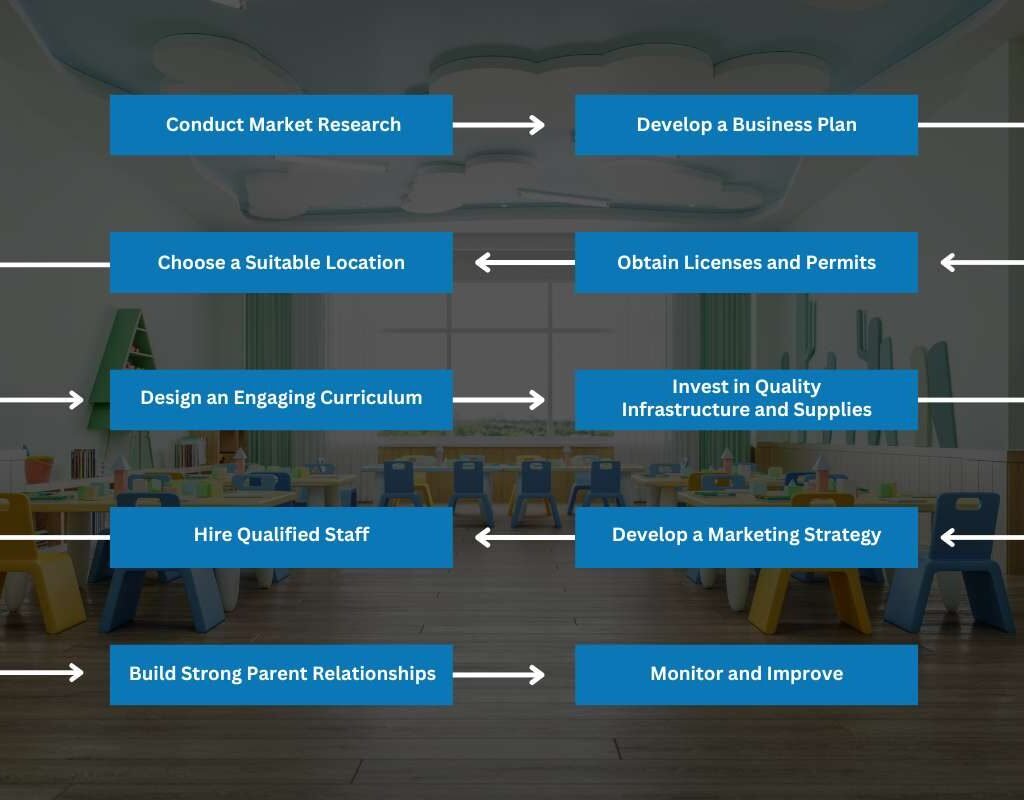Establishing a preschool venture is very fulfilling and profitable. Today, parents are keenly looking for good early childhood education for their lovable children. This makes the preschool industry a very exciting one for entrepreneurs. However, to start a Successful Preschool Business, it needs thorough planning, passion for early childhood education, and intelligent execution.
Understanding the Preschool Business Landscape
Before moving into the process of opening your preschool, it is important to understand the industry. Preschool education is gaining ground because parents are becoming aware of the advantages of early childhood education. Children attend preschool; they fare well academically and socially, which has led to an increase in enrollments.
Now, with that being said, let us dive into the crucial steps that one has to take in order to set up a successful preschool business.

Step 1: Conduct Market Research
Market research is the foundation of any successful business. To start a successful preschool business, you will need to analyze the competition, identify gaps in the market, and understand the needs of your target audience. Ask yourself:
- Who are my competitors?
- What services do they offer?
- What age groups are most in demand?
- What is the average tuition rate in the area?
Armed with this data, you can craft a unique value proposition for your preschool.
Step 2: Develop a Business Plan
A well-developed business plan is fundamental to your preschool’s prosperity. This is the plan that would guide the establishment and will be very effective in attracting potential investors or even obtaining loans. The main elements that should feature in this business plan are:
- Mission and vision: Define the purpose and goals of your preschool.
- Target audience: Specify the age groups and demographics you plan to serve.
- Location strategy: Identify a convenient, safe, and accessible site for your preschool.
- Financial projections: Estimate startup costs, operational expenses, and expected revenue.
Remember, a clear business plan not only ensures smoother operations but also helps you achieve your long-term objectives.
Step 3: Choose a Suitable Location
The location of your preschool is very important to its success. It should be safe, child-friendly, and accessible. The location should also comply with zoning laws and safety regulations. The proximity to residential neighborhoods or workplaces is also important since convenience is a top priority for parents.
The facility should also have enough space for classrooms, play areas, and administrative offices. Outdoor space for physical activities is a bonus.
Step 4: Obtain Licenses and Permits
To begin a successful preschool business, local regulations have to be strictly adhered to. Though the necessities vary according to the region, some are very commonly required:
- Business License
- Fire safety clearance
- Health department approval
- Early childhood education certification (for staff)
Research the legal requirements in your area and ensure all documentation is in place before opening.
Step 5: Design an Engaging Curriculum
The curriculum is the heart of any preschool. It ought to be age-appropriate, engaging, and meet the standards of early childhood education. Activities that ought to be focused on developing cognitive, social, emotional, and physical skills. Balance these with:
- Storytelling and reading
- Arts and crafts
- Music and dance
- Outdoor play
Consider adopting a recognized teaching approach, such as Montessori, Reggio Emilia, or play-based learning, to set your preschool apart.
Step 6: Invest in Quality Infrastructure and Supplies

The learning environment plays a crucial role in a child’s development. Invest in:
- Child-sized furniture
- Educational toys and materials
- Safe play equipment
- Books and art supplies
Ensure the space is bright, clean, and inviting. Childproof the facility to prioritize safety, and include amenities like first-aid kits and fire extinguishers.
Step 7: Hire Qualified Staff
Your staff will determine the experiences that children will have and what your preschool’s reputation will be. Hire qualified educators in early childhood education and passionate about working with young children. Also, check their background and provide regular training to keep them up to date on best practices.
Support staff, including administrative personnel and cleaners, are also important to maintain smooth operations.
Step 8: Develop a Marketing Strategy
A good marketing plan is a must to attract enrollments. Online and offline strategies should be mixed:
- Create a website: Showcase your curriculum, facilities, and testimonials.
- Use social media: Engage with parents and share updates.
- Distribute flyers: Highlight key features of your preschool in local communities.
- Offer promotions: Discounts for early registrations or sibling enrollments can be appealing.
Word-of-mouth is very powerful in the preschool industry, so focus on building trust and delivering excellent services.
Step 9: Build Strong Parent Relationships

Parents form your primary stakeholder’s network. To launch a Successful Preschool Business, establishing good working relations with parents is pivotal. Good communication, transparency, and promptness do much work. Hold parent-teacher conferences, newsletters, and open houses to keep them appraised and engaged.
Step 10: Monitor and Improve
Once your preschool is operational, continually monitor its performance. Gather feedback from parents, staff, and even children to identify areas for improvement. Stay updated on industry trends and adapt accordingly. Introducing new programs or enhancing existing ones can keep your preschool competitive and relevant.
Final Thoughts
Establishing a preschool business comes with quite some demands; it uses strategic planning and child passion to bring about early childhood education. These steps, together with the dedication to building a loving environment, will allow one to start a successful preschool business without a doubt for the children and their families. With hard work and creativity, you can make your preschool on-demand in society such that it will live long memories in the hearts of young ones.








